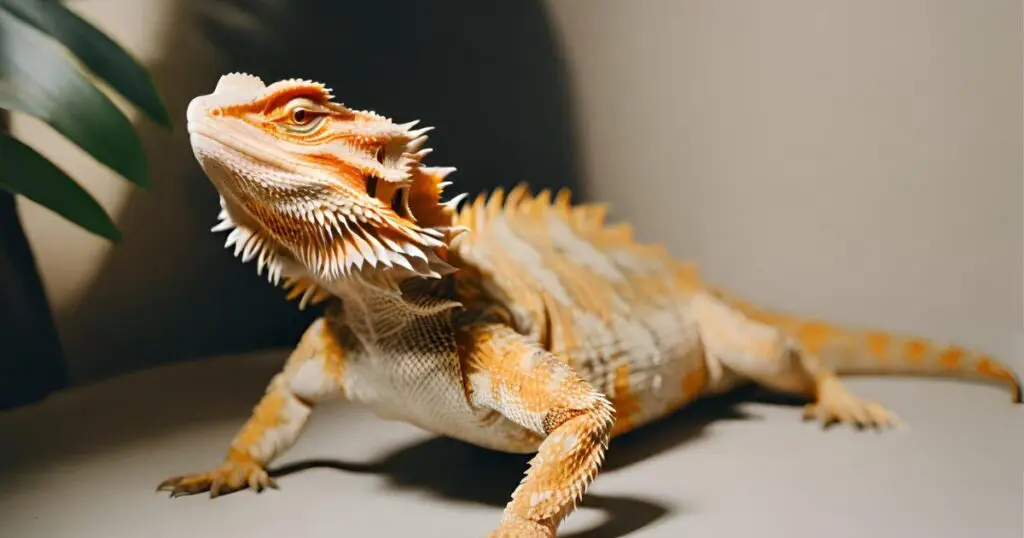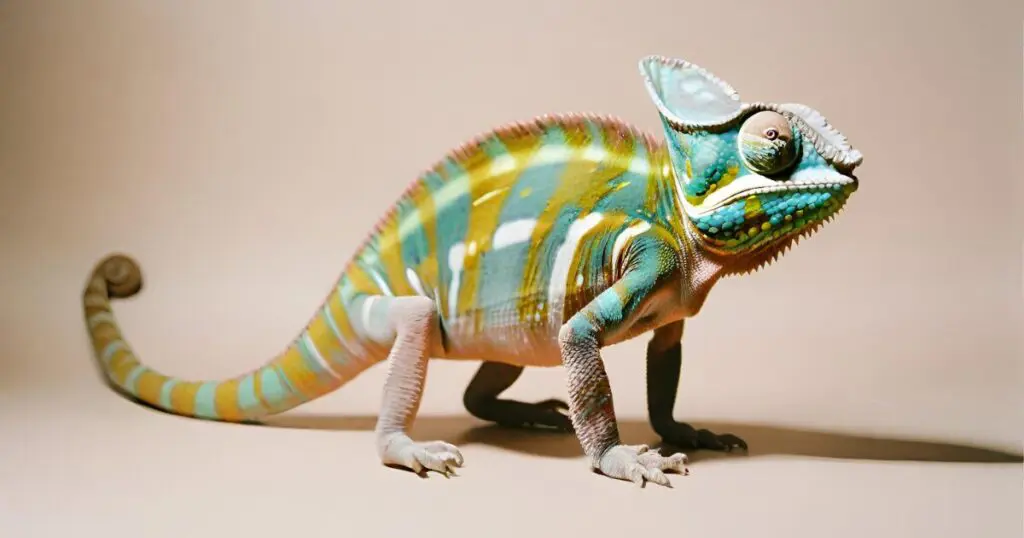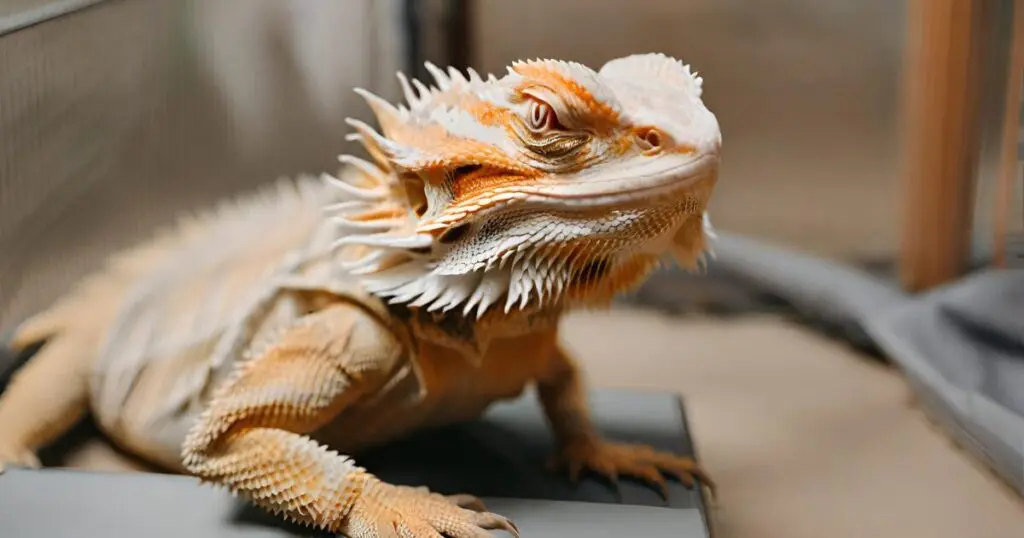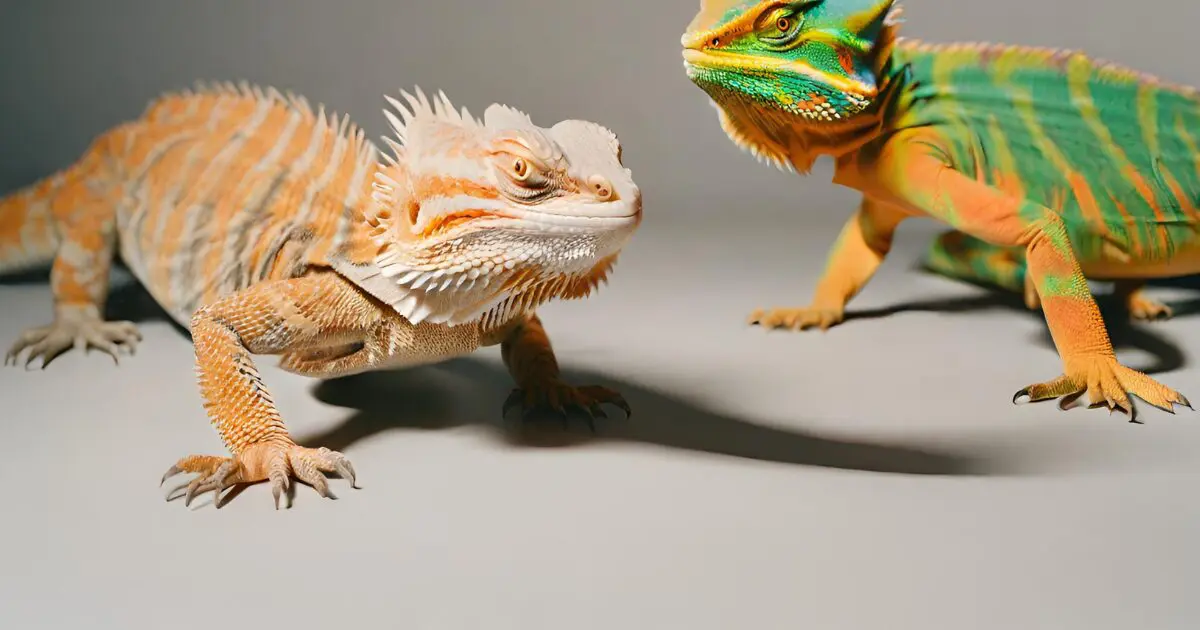“Bearded dragon vs chameleon, which one should I go for?” One of my friends asked me this question recently. Look, I have a beardie, so I wanted to tell him to go for them, but I figured it would be better if we discussed the pros and cons of both lizards.
The most obvious difference between bearded dragons and chameleons is their appearance. Bearded dragons are stout lizards from Australia covered in spiky scales. They come in a range of earthy colors like tan, brown, and reddish orange. Chameleons are more easily stressed and prefer less handling.
By now, you’re probably starting to get a feel for which reptile aligns better with your preferences. To help make the decision process even clearer, I’ll be going over all the key differences between these two reptiles.
Bearded Dragon vs Chameleon: An Overview
Let me give you an overview of these two lizards first. This will be helpful for you.
| Characteristic | Bearded Dragon | Chameleon |
| Size | Medium | Small to Medium |
| Native Location | Australia | Various |
| Tail | Short, stocky | Long, prehensile |
| Camouflage | Limited | Excellent |
| Eyes | Bulging | Independent |
| Diet | Insects, veggies | Insects, foliage |
| Lifespan | 10-15 years | 5-10 years |
| Defensive Attack | Bite, puff up | Bite, hiss |
| Calmness | Relatively calm | Variable |
| Intelligence | Moderate | High |
| Number of species | 8 | Around 150 |
| Appearance | Scales, spiky | Scales, smooth |
| Speciality | Basking | Camouflage |
| Trainability | Moderate | Limited |
| Grooming needs | Low | Low |
| Exercise | Moderate | Limited |
| Availability | Common | Common |
| Popularity as pet | Very popular | Popular |
Bearded Dragon vs Chameleon: Differences
Bearded dragons and chameleons are different in many ways. Spike, my bearded dragon, helped me a lot while making the comparison. So, it’s already a plus 1 for beardies. 😉
1. Appearance
A bearded dragon looks totally different from a chameleon! They are kind of chunky and flat-bodied, unlike those super skinny chameleons. Spike is covered in little spiny scales that feel prickly if you pet him the wrong way. They come in earthy colors like sandy yellow, reddish brown, or olive green.
Chameleons have really skinny bodies and tails, and they can curl around branches. Their feet and tails are shaped like grabbers to cling onto trees. They’ve got these awesome swirly horns and fins on their heads that remind me of something from Jurassic Park!
Oh, and obviously, chameleons can change color, but bearded dragons pretty much stay the same shades.

2. Native Location
Spike is a real desert dude originally from Australia. Chameleons prefer rainforests and are found in Africa and parts of Asia.
Australia is hot and dry, with lots of sand and scrubby vegetation, so bearded dragons evolved to handle the heat. Chameleons live high up in tropical trees and are adapted to blend into all the green leaves around them.
3. Camouflage
Bearded dragons aren’t exactly built for camouflage. Their spiky bodies and earth-tone colors help them blend into the desert environment a little. However, they are not great at hiding.
Chameleons, on the other hand, are masters of disguise! Their color-changing ability lets them match their surroundings perfectly to avoid predators. They turn green in the trees, brown on the soil, and even have weird patterns to imitate sun flecks. Crazy cool camo skills!
4. Diet
Bearded dragons are omnivores. My spike eats both plants and meat. He likes leafy greens, veggies like carrots and cucumbers, and some fruit, but he also enjoys insects like crickets, worms, and roaches for protein.
Chameleons are totally bug-eating machines that don’t eat much plant material. They have long, sticky tongues. They can grab insects out of the air using their tongues. Some bigger chameleon species can eat small birds and rodents, too.
Can bearded dragons eat onions?
5. Lifespan
With proper care, bearded dragons usually live 6-10 years, which is pretty decent for a lizard. Chameleons tend to have shorter life spans of just 2-5 years, unfortunately. Since chameleons are more sensitive, they require really precise habitat conditions to thrive in captivity long-term.
6. Defensive Attack
When threatened, bearded dragons will sometimes puff up their throat to appear more intimidating. But they’re pretty mellow lizards who rarely bite people.

Chameleons take skittishness to the next level. If scared, some species can shoot their sticky tongue out as far as two body lengths to try and slap enemies! You definitely don’t want to be on the receiving end.
7. Nature
My bearded dragon Spike is a pretty chill little guy. Compared to those high-strung chameleons, beardies have a mellower personality. They’ll happily sit on your lap for pets and cuddles. Chameleons tend to be really easily stressed out and startled.
You have to move slowly and speak softly around chameleons. Spike has never once tried to bite or whip me with his tail! But some chameleons get aggressive when threatened and will lunge or slap.
8. Intelligence
I wouldn’t say Spike is the brainiest lizard, but he’s smart enough to recognize me and respond to his name. He even learns little tricks like touching his nose to my finger.
Chameleons have more complex brains and excellent eyesight that help them hunt. They can focus each eye separately to scan for prey and gauge distances. Pretty advanced compared to the bearded dragon brain!
9. Appearance
With chunky bodies and spiky scales, bearded dragons look totally prehistoric. And those cute beardie “beards” when they puff out their throat are so funny.
Chameleons have really unique features like curly tails, horned crests, and, of course, color-changing skin. They look incredibly alien and complex. All those fins and horns remind me of elaborate costumes.
10. Speciality
Bearded dragons don’t really have any special talents. Their best features are being calmly handled and tolerating beginner mistakes. But color-changing definitely makes chameleons special! Adjusting their scales to match their surroundings helps camouflage from predators. It’s also used for temperature regulation and communication.
11. Trainability
Spike has learned to walk on a leash and do little tricks for treats. Bearded dragons are intelligent enough for basic obedience training. Chameleons are so independent and self-reliant in nature that they don’t really thrive with training. Their cryptic instincts make bonding with people unnatural for them.
12. Grooming needs
I give Spike an occasional bath to help shed his skin. Nonetheless, these dragons are pretty low maintenance in the grooming department.
Chameleons need a lot more specialized care, like misting their scales so they don’t get dehydrated. Their intricate crests and horns have to be kept clean, too.
Bearded dragons vs Horned toads
13. Exercise
Spike is satisfied with roaming his tank during the day, basking, and exploring outside during playtime. Chameleons need huge screened cages with branches and vines so they can climb and hunt like they would in the wild. So chameleons need way more exercise space!
14. Availability
Finding a bearded dragon, like my spike, is super easy. Pet stores tend to have baby beardies in stock pretty often since they breed readily in captivity. You can also find reputable breeders online. Around 700,000 people in the US have pet beards these days.
Bearded dragons hold the title of the most popular pet reptile species in numerous countries, including Australia (78% of reptile searches), Western Europe (44-46% in several countries), Canada (33%), and the US (40%).
Chameleons are a little trickier to acquire. Since captive breeding can be difficult, many chameleons for sale are wild-caught imports. Make sure to buy from a responsible source so you get a healthy animal. Some species are still quite rare, too!
15. Popularity as Pet
Bearded dragons have totally exploded in popularity over the last decade. They went from this niche lizard to one of the most recommended beginner reptiles. Beardies are super chill with handling, have simple care needs, and come in fun morph colors.
Chameleons need huge screened cages, humid conditions, and lots of live insects. Beginners often struggle with their complex needs. Plus, chameleons aren’t cuddly pets you can hold. So I get why bearded dragons are in such high demand – they fit most families’ lifestyles better.

Bearded Dragon vs Chameleon: Similarities
While bearded dragons and chameleons may seem vastly different at first glance, they actually share some key traits and care requirements as reptiles.
- Both species are lizards belonging to the suborder Iguania
- Neither chameleons nor bearded dragons should be housed together due to territorial behaviors
- Both require UVB lighting and supplemental calcium for healthy bone development
- Cages must be thoroughly cleaned and disinfected regularly to prevent disease
- Chameleons and bearded dragons are solitary animals who become stressed when overcrowded
- They are both primarily insectivores, with some plant matter in bearded dragon diets
- Neither handles temperature fluctuations well – stable heating is critical
- Signs of sickness include lethargy, lack of appetite, and changes in appearance
- Their enclosures need places to hide, climb, bask, and feel secure
Bearded Dragon vs Chameleon: Which Is Better as a Pet?
When it comes to deciding between a bearded dragon or a chameleon as a pet, there’s a lot to weigh up! Let me break down the pros and cons of each one from my experience.
For bearded dragons, the biggest pro is definitely their chill personality. Spike has no problem snuggling with me while I watch TV or just hanging out on my shoulder. Chameleons tend to be far more easily stressed by handling.
Another beardie pro is their simple diet – greens and veggies with some insects. It’s way less work than finicky chameleons that only want live bugs!
In terms of cons, bearded dragons need a pretty big tank, regular baths to stay hydrated, and strong UVB lighting. The startup costs add up.
Chameleons have awesome pros, like their otherworldly appearance and magical color-changing abilities. Just watching them crawl through branches hunting crickets can make you feel like you are in the rainforest.
So, in my opinion, bearded dragons make better pets for first-time or casual reptile owners who want durability and companionship. But advanced keepers up for a challenge will find chameleons incredibly rewarding. It all comes down to what you’re looking for in a pet lizard!
FAQ
Some questions that may come to your mind while reading this article.
Q: Which reptile is better with children?
Bearded dragons tend to have a calmer disposition and tolerate handling well, so they are generally the better choice for families with younger children. Chameleons are more likely to become stressed by loud noises and activity.
Q: How big of an enclosure does each need?
An adult bearded dragon requires at least a 40-50 gallon tank. Chameleons need huge screened cages, often 4 feet x 2 feet x 6 feet for adult veiled chameleons.
Q: What is the temperature range needed for their habitats?
Bearded dragons thrive at 105-110°F for their basking spot and 70-80°F on the cool end. Chameleons need a temperature gradient from 70-85°F to regulate body temperature.
Conclusion
When looking at bearded dragon vs chameleon ownership, both reptiles have unique advantages and challenges. Bearded dragons make hardy, handleable pets for beginners. Chameleons offer advanced keepers a stunning but demanding species to master. Do your research and reflect carefully on which pet’s needs best fit your experience level and lifestyle.
You can also read:
https://pubmed.ncbi.nlm.nih.gov/33802560/
